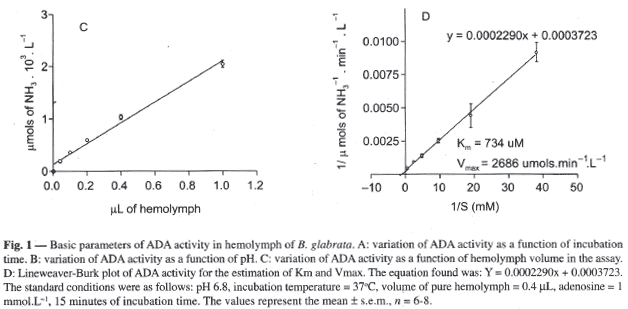Adenosine is an important signaling molecule for many cellular events. Adenosine deaminase (ADA) is a key enzyme for the control of extra- and intra-cellular levels of adenosine. Activity of ADA was detected in hemolymph of B. glabrata and its optimum assay conditions were determined experimentally. The pH variation from 6.2 to 7.8 caused no significant change in ADA activity. Using adenosine as a substrate, the apparent Km at pH 6.8 was 734 µmols.L-1. Highest activity was found at 37ºC. Standard assay conditions were established as being 15 minutes of incubation time, 0.4 µL of pure hemolymph per assay, pH 6.8, and 37ºC. This enzyme showed activities of 834 ± 67 µmol.min-1.L-1 (25ºC) and 2029 ± 74 µmol.min-1.L-1 (37ºC), exceeding those in healthy human serum by 40 and 100 times, respectively. Higher incubation temperature caused a decrease in activity of 20% at 43ºC or 70% at 50ºC for 15 minutes. The ADA lost from 26 to 78% of its activity when hemolymph was pre-incubated at 50ºC for 2 or 15 minutes, respectively. Since the ADA from hemolymph presented high levels, it can be concluded that in healthy and fed animals, adenosine is maintained at low concentrations. In addition, the small variation in activity over the 6.2 to 7.8 range of pH suggests that adenosine is maintained at low levels in hemolymph even under adverse conditions, in which the pH is altered.
adenosine deaminase; Biomphalaria glabrata; hemolymph



